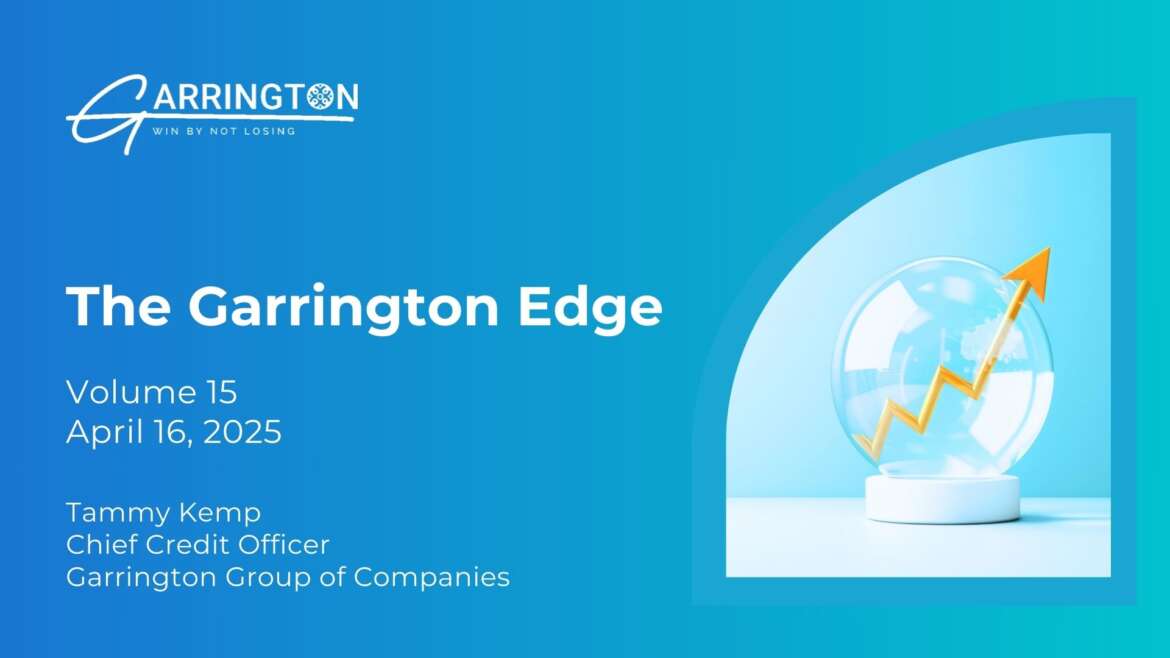Plan for the Worst and Hope for the Best.
When we underwrite loans, we are always thinking about the exit; how will we get our money back?
Planning for a terminal event we obtain appraisals on collateral so that we understand the current value, investigating the market and our prospective client’s resiliency. Furthermore, we look at historical financial and collateral performance as predictors of future performance.
This approach assumes that the environment in which borrowers operate are relatively consistent, or that historical headwinds repeat. If only it were that simple. We add to this mix our collective experiences working through challenging periods and adherence to our credit policies.
Protectionist tariffs have been utilized in the past to stabilize specific or problematic areas of economies by governments. Historically these measures have been pointed and specific, which have been easier to manage from a lender’s point of view.
The current landscape is considerably different.
The tariffs are broad in their application and have global implications.
There are real impacts hitting the North American economy and our best response is to be measured and thoughtful.
I would like to share how our portfolio is faring under these pressures and our approach to these challenges.
Firstly, we have not ceased funding any clients in response to the changing environment. As a result, we have not identified any defensive funding requests, or pre-emptive fundings to secure a war chest of cash. We have not seen a wholesale change in payment practices, defaults or valuations across the portfolio. We have identified specific clients that we believe have a heightened vulnerability to the tariffs. while focusing our attention on the top ten to fifteen positions in the portfolio.
Our approach to client management is not reactive; our approach is to lead with conversation and understanding. If we better understand the problem or issue, the more likely it is we can work together on solutions which protect our capital. However, we are not naïve, some businesses will not survive. It is too early however to make reasonable determinations on who may land where.
In general terms our portfolio is somewhat naturally hedged operating both in the US and Canada.
Additionally, particularly in our factoring portfolio where clients are generally regionally focused, there is very little cross border exposure.
Key to this discussion is also our approach and strategy, initially looking at our top ten clients and their potential risks and exposure (both from a direct tariff perspective and a general business resiliency perspective) in what has already been a rising inflation and potential recession environment.
Our general approach of offering factoring, asset-based lending and lines of credit to other lenders has resulted in a balanced portfolio across our verticals. In all verticals we are focused on collateral values and underwrite to a potential terminal event, so in that way the verticals can be seen primarily as an efficient means of categorization.
Factoring
Direct factoring transactions currently represent approximately 27% of our deployed funds. Factoring transactions are closest to cash transactions, generally closing out on a 60-day cycle. We make funding decisions daily focused on counterparty risks. Assessing counterparty risk is critical, while having current access to trends and credit information from multiple sources aids decision making. Our factoring portfolio is enhanced by in-house professional credit managers and access to external credit professionals through our credit insurance policy.
We have three Factoring Facilities within our top ten positions.
These three borrowers do not share customers; they each provide contracted services that are difficult to source alternatively; and they are all regionally focused in specific areas of the US.
Only one may have limited exposure to tariff impacts as they do provide steel fabrication. However, their products are unique, and they are the single source supplier to their key customer. Steel is purchased as purchase orders are raised, so pricing risks should be mitigated. The most notable current risk may be a slow down of orders. However, the company also provides service workers, so they have the capacity to pivot their crews according to demand.
Our other two borrowers provide an embedded service and rely upon subcontractors to scale as needed. The projects are regionally located and serviced by companies who are close by. Once a project is started it will run until completed. Receivables will ramp as the project unfolds. The business risk at scale, however, is mitigated by using third parties and can rapidly right size as a project finishes. We do not see the demand for these projects slowing – in fact they may expand due to tariff impacts.
Commercial SME Finance
The Commercial SME portfolio represents approximately 22% of our deployed funds. This segment of our portfolio is comprised of revolving lines of credit to commercial lenders who lend to small and medium sized businesses, with tangible assets as collateral.
We must therefore look beyond our client’s individual exposure and dive deeply into our client’s portfolio to identify potential risks.
We have two Commercial SME Finance Facilities within our top ten positions.
Our largest client is another factoring/asset-based lender. Each position in their portfolio is well known to us, as each position is approved as eligible for the borrowing base, and we track collateral performance alongside our client on their top positions.
Our client has over one hundred distinct credit facilities within their portfolio. Together we have identified two positions within their top ten that may have risks due to the tariffs.
The first imports a key raw material from a country that is impacted by import tariffs. This country has not imposed reciprocal tariffs therefore the imposed tariffs are relatively low. This borrower has a significant stock of raw materials on hand, primarily due to anticipated demand that was projected at the end of last year. Discussions are ongoing with this client. The risk is deemed to be low due to potential other sources of the raw material and the client’s ability to pass along cost increases.
The second borrower with potential risk is still under review. The company has inventory on hand and multiple avenues for sales locally. In addition, risks are further mitigated by additional collateral held in support of the facility that is unrelated to the business and tariff risks, namely real estate collateral.
The second Commercial SME Finance Facility is for a fund manager. Their primary fund holds mortgages on properties undergoing development at various stages. Increased costs due the tariffs will have an impact on completion budgets, potentially impacting valuations and completion dates. To mitigate these impacts, we have focused on projects with near term liquidity events. There are three such projects, the most significant of which will repay the current revolving facility outstanding balance in full and is expected to close by mid May. Should this liquidity event fail to materialize as expected, it is important to note that this fund currently has over $260 million in eligible assets that support cashflow and debt repayments (against a loan value which as of the end of March sits at under $10 million).
Lender Finance
Our third vertical is Lender Finance where we provide revolving lines of credit based on the value of finance portfolios. This vertical currently holds four credit facilities within our top ten. It represents approximately 25% of our deployed funds.
In the largest position, we do not see any direct tariff risk. The underlying portfolio is low loan to value mortgages to well qualified consumers. There is a risk generally due to debt pressures on consumers in a rising cost environment, but we have not seen a change related to this pressure to date.
The remaining three facilities have potential tariff exposure, which can be managed and mitigated. All three provide loans/leases to consumers for the purchase of used vehicles. Two of the borrowers are Canadian the other is US based company. We see the risk to all three being the same, a significant rise in the cost of vehicles. As the cost of new cars potentially increase significantly due to the tariffs, used vehicles will become more difficult to source (people will hold onto to their existing cars longer) and the price will rise.
We saw this same impact during COVID. The result for the consumer was less choice, higher costs and longer lease terms. For our clients, it increased borrowings and reduced early returns due to the lower monthly amortizations. We mitigated these impacts by encouraging clients to slow portfolio growth, having these clients be more selective about the loans/leases they choose to write. Their portfolios were therefore less impacted, and as vehicle prices slowly returned to pre-pandemic values, they had borrowing base room to restart their growth. The same thoughtful and prudent approach is being discussed today.
Asset-Based Landing
Our final vertical for this review is Asset-Based Lending (sitting at approximately 26% of the deployed funds)
Our only ABL client within the top ten is a consumer goods supplier in the US. They source raw materials and sell domestically. We have not identified a direct risk to their business from tariffs. There is a risk that consumer spending will be impacted. However, their products are low-cost and have historically continued to perform during periods of restrained consumer spending.
In Closing
The bottom line is that there are risks inherent in our portfolio both directly linked to tariffs and certainly linked to potential ancillary impacts, most notably the likely resulting recession.
Despite the looming trade war and recession, we know that commerce will continue. There will be winners and losers, but it is likely too early to predict who will land where.
We continue to operate with the mindset that our best protection lies in remaining vigilant and “sticking to our knitting.” We remain focused on identifying risks, staying close to clients, and being attentive as trends emerge. With this approach, we gain clarity on the evolving environment, thus providing time to respond thoughtfully to protect capital.
Similarly, when evaluating new opportunities, we continue to stress testing for tariff risks and general business resiliency, as we have for the last few years during the rising rate and inflationary environment.
Garrington’s investment strategy and processes have been built over the last twenty-five years. Our portfolio today is stronger than ever with key portfolio statistics as at March 31 including:
- Over 100 loans in the portfolio
- Secured first-lien facilities comprise 99% of the portfolio
- Portfolio duration @ 6 months
- Average weighted LTV @ 61%
- Almost all the borrowers in the portfolio are paying monthly cash interest payments
We anticipate uncertainty and turbulence this year. Our strategy remains focused on identifying problems early so we have multiple avenues of recovery and prudence when contemplating new transactions; this will not change. Stress testing resiliency will pivot away from interest rate sensitivity to gross margins, supply chains, and alternative market strategies.





